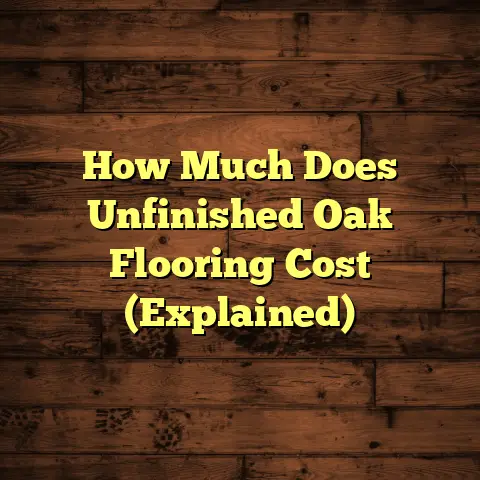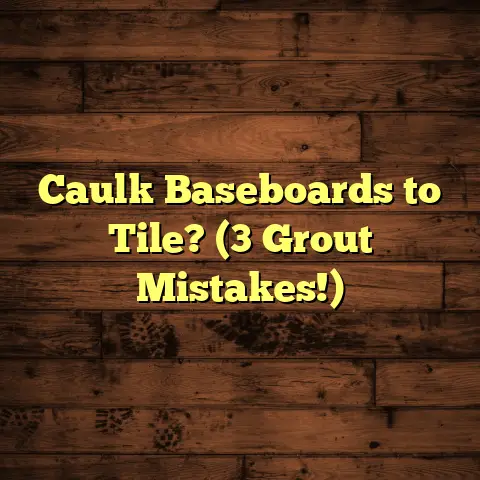How to Waterproof Wood Floors? (6 Sealant Secrets!)
Have you ever dreamed of having beautiful wood floors that can withstand anything life throws at them?
I’m talking about floors that laugh in the face of spills, shrug off humidity, and still look stunning years down the line.
Well, that dream can become a reality with waterproof wood floors!
Let me tell you, as a flooring contractor with years of experience, I’ve seen firsthand the devastation water can wreak on unprotected wood.
But I’ve also seen the incredible transformation that waterproofing can bring.
Think of it this way: Waterproofing is like giving your wood floors a superpower – the power to resist moisture and stay beautiful for years to come.
In this article, I’m going to share my insider secrets on how to waterproof your wood floors like a pro.
We’ll dive into everything from understanding the need for waterproofing to choosing the right sealant and applying it like a boss.
So, grab a cup of coffee, settle in, and let’s get started on your journey to waterproof wood floor nirvana!
Section 1: Understanding the Need
for Waterproofing
What is Waterproofing?
Okay, let’s start with the basics.
What exactly is waterproofing when it comes to wood floors?
Simply put, it’s the process of making your wood floors resistant to water damage.
This involves applying a special sealant or finish that creates a protective barrier, preventing water from seeping into the wood fibers.
Think of it like applying sunscreen to your skin – it shields your floors from the harmful effects of moisture.
Why is this so important?
Well, wood is a natural material, and it’s inherently porous.
That means it readily absorbs water, which can lead to a whole host of problems.
Common Issues with
Non-Waterproof Wood Floors
Trust me, I’ve seen it all.
From minor annoyances to full-blown disasters, non-waterproof wood floors can be a real headache.
Here are some of the most common issues:
Warping: When wood absorbs water, it expands.
If the expansion is uneven, it can cause the wood to warp, creating unsightly bumps and dips in your floor.
I once had a client whose entire living room floor had to be replaced due to severe warping caused by a leaky pipe.Staining: Water can carry stains from spills, pet accidents, or even just dirty shoes deep into the wood fibers.
These stains can be incredibly difficult, if not impossible, to remove.
I remember a homeowner who tried everything to get rid of a coffee stain on their oak floor, but it was permanently embedded in the wood.Mold Growth: This is perhaps the most serious issue.
When wood stays damp for extended periods, it creates the perfect breeding ground for mold and mildew.
Mold can not only damage your floors but also pose a serious health risk to you and your family.
According to the EPA, mold can cause a variety of health problems, including respiratory issues, allergies, and even neurological problems.
(Source: EPA.gov)Humidity: Even without direct contact with water, high humidity can wreak havoc on wood floors.
The moisture in the air can be absorbed by the wood, leading to swelling, cupping, and cracking.
I’ve seen this happen frequently in coastal areas or homes with poor ventilation.
These problems can not only ruin the appearance of your floors but also significantly decrease their lifespan.
According to the National Wood
Flooring Association (NWFA), proper
maintenance, including
waterproofing, can extend the life
of your wood floors by decades.
(Source: NWFA.org)
Benefits of Waterproof
Wood Flooring
Now, let’s talk about the good stuff.
What are the benefits of having waterproof wood floors?
Here are just a few:
Enhanced Durability: Waterproofing protects your floors from damage, making them more resistant to wear and tear.
This means they’ll last longer and require less frequent repairs or replacements.Ease of Cleaning: Waterproofed floors are much easier to clean than non-waterproofed floors.
Spills can be quickly wiped up without leaving stains or causing damage.
You can say goodbye to hours of scrubbing and worrying about stubborn stains.Increased Home Value: Let’s face it, everyone loves a beautiful and well-maintained home.
Waterproofed wood floors can significantly increase your home’s value, making it more attractive to potential buyers.Peace of Mind: Perhaps the greatest benefit of all is the peace of mind that comes with knowing your floors are protected from water damage.
You can relax and enjoy your beautiful wood floors without constantly worrying about spills or leaks.
Section 2: Types of Waterproof
Wood Flooring Products
Okay, now that we understand the importance of waterproofing, let’s explore the different types of waterproof wood flooring products available.
Engineered Wood vs.
Solid Wood
First, it’s important to distinguish between engineered wood and solid wood.
Solid Wood: This is exactly what it sounds like – planks made from a single piece of wood.
Solid wood floors are beautiful and can last for generations, but they’re also more susceptible to moisture damage.
Solid wood expands and contracts more readily than engineered wood, making it more prone to warping and cracking in humid environments.Engineered Wood: Engineered wood consists of multiple layers of wood veneer glued together.
The top layer is typically a high-quality hardwood, giving it the same appearance as solid wood.
However, the layered construction makes engineered wood more stable and less prone to moisture damage.
While neither type is inherently waterproof, engineered wood generally performs better in humid environments due to its construction.
However, both solid and engineered wood floors can be waterproofed with the right finishes and sealants.
Water-Resistant Finishes
Now, let’s talk about finishes.
These are the coatings applied to the surface of your wood floors to protect them from wear and tear, including water damage.
Here are some of the most common types of water-resistant finishes:
Oil-Based Finishes: Oil-based finishes are durable and provide a warm, rich color to wood floors.
They offer good water resistance, but they can yellow over time and require more frequent reapplication.Water-Based Finishes: Water-based finishes are more environmentally friendly than oil-based finishes and dry much faster.
They offer good water resistance and are less likely to yellow over time.
However, they may not be as durable as oil-based finishes.Polyurethane Finishes: Polyurethane finishes are the most popular choice for waterproofing wood floors.
They’re durable, water-resistant, and available in a variety of sheens, from matte to high-gloss.
Polyurethane finishes can be either oil-based or water-based, with water-based polyurethane being the more popular choice due to its lower VOC content and faster drying time.
In addition to these traditional finishes, there are also newer, more advanced waterproof coatings available, such as:
-
Acrylic-Infused Wood: This type of flooring has acrylic infused into the wood, making it virtually waterproof.
-
Luxury Vinyl Plank (LVP) with Wood-Look: While not technically wood, LVP offers a realistic wood look and is completely waterproof.
Manufacturers’ Innovations
The flooring industry is constantly innovating, and there are some amazing new waterproof wood flooring products on the market.
Here are a few brands that are leading the way:
-
Shaw Floors: Shaw offers a variety of waterproof hardwood floors with their innovative Repel Water Resistant Technology.
-
Armstrong Flooring: Armstrong’s Performance Plus Hardwood flooring is designed to resist water damage and scratches.
-
Mohawk Flooring: Mohawk’s RevWood Plus is a waterproof laminate flooring that looks and feels like real wood.
These manufacturers are pushing the boundaries of what’s possible with waterproof wood flooring, and their products are definitely worth considering if you’re looking for the ultimate in water protection.
Section 3: Preparing Your Wood
Floors for Waterproofing
Before you start slathering on the sealant, it’s crucial to prepare your wood floors properly.
This will ensure that the sealant adheres correctly and provides the best possible protection.
Assessment
First, take a good, hard look at your floors.
Are there any signs of existing water damage, such as warping, staining, or mold growth?
Are there any loose or damaged planks that need to be repaired or replaced?
Are there any gaps between the planks that need to be filled?
Addressing these issues before waterproofing is essential.
If you have significant water damage or mold growth, it’s best to consult with a professional flooring contractor.
They can assess the extent of the damage and recommend the best course of action.
Cleaning and Repair
Once you’ve assessed your floors, it’s time to clean and repair them.
Here’s a step-by-step guide:
-
Remove Furniture and Rugs: Clear the area completely to allow for thorough cleaning and repair.
-
Sweep or Vacuum: Remove any loose dirt, dust, and debris from the floor.
Clean the Floors: Use a wood floor cleaner specifically designed for your type of finish.
Avoid using harsh chemicals or abrasive cleaners, as these can damage the finish.Repair Damaged Planks: If you have any loose or damaged planks, repair or replace them.
You can use wood glue to secure loose planks or replace damaged planks with new ones.Fill Gaps: Use wood filler to fill any gaps between the planks.
Allow the wood filler to dry completely before sanding.Sand the Floors: Sanding is essential for creating a smooth, even surface for the sealant to adhere to.
Use a floor sander with progressively finer grits of sandpaper, starting with a coarse grit and finishing with a fine grit.
Be sure to wear a dust mask and eye protection when sanding.Vacuum and Tack Cloth: After sanding, vacuum the floors thoroughly to remove any sanding dust.
Then, use a tack cloth to remove any remaining dust particles.
Tools and Materials Needed
Here’s a list of the essential tools and materials you’ll need for the waterproofing process:
-
Wood Floor Cleaner: Choose a cleaner specifically designed for your type of finish.
-
Wood Filler: For filling gaps between planks.
-
Floor Sander: For sanding the floors to create a smooth, even surface.
-
Sandpaper: Various grits, from coarse to fine.
-
Vacuum: For removing dust and debris.
-
Tack Cloth: For removing remaining dust particles.
-
Sealant: Choose a high-quality sealant specifically designed for waterproofing wood floors.
-
Brushes and Rollers: For applying the sealant.
-
Paint Tray: For holding the sealant.
-
Protective Gear: Including a dust mask, eye protection, and gloves.
Section 4: The Sealant Secrets
Alright, now for the moment you’ve all been waiting for – the sealant secrets!
These are the tips and tricks I’ve learned over the years that will help you achieve professional-level waterproofing results.
Secret #1: Choosing the
Right Sealant
Choosing the right sealant is crucial for achieving long-lasting waterproof protection.
Here are some factors to consider:
Floor Type: Different sealants are designed for different types of wood floors.
Make sure to choose a sealant that’s specifically formulated for your type of wood and finish.Usage: Consider the amount of traffic your floors will be subjected to.
If you have a busy household with kids and pets, you’ll need a more durable sealant than if you have a quiet home with minimal foot traffic.-
Water Resistance: Look for a sealant that’s specifically labeled as “waterproof” or “water- resistant.” Read the product description carefully to understand the level of water protection it provides.
VOC Content: VOCs (volatile organic compounds) are chemicals that can be released into the air during and after application.
Choose a sealant with low VOC content to minimize indoor air pollution.Ease of Application: Some sealants are easier to apply than others.
Consider your skill level and choose a sealant that you feel comfortable working with.
Secret #2: The Importance
of Application Technique
Even the best sealant won’t perform well if it’s not applied correctly.
Here are some best practices for applying sealant:
-
Read the Instructions: Always read and follow the manufacturer’s instructions carefully.
Apply Thin Coats: Apply the sealant in thin, even coats.
Thick coats can take longer to dry and may be more prone to bubbling or peeling.-
Use the Right Tools: Use a high-quality brush or roller specifically designed for applying sealant.
-
Overlap Each Stroke: Overlap each stroke slightly to ensure complete coverage.
Avoid Bubbles: Work carefully to avoid creating bubbles in the sealant.
If you do see bubbles, use a brush to gently smooth them out.-
Maintain a Wet Edge: When applying sealant to a large area, maintain a wet edge to prevent lap marks.
Secret #3: Layering for
Maximum Protection
Applying multiple layers of sealant is essential for achieving maximum waterproof protection.
Each layer of sealant adds an extra barrier against moisture, making your floors more resistant to water damage.
I recommend applying at least two coats of sealant, and preferably three.
Be sure to allow each coat to dry completely before applying the next.
Check the manufacturer’s instructions for the recommended drying time between coats.
Secret #4: Maintenance After
Waterproofing
Waterproofing is not a one-time thing.
To maintain the waterproof protection of your floors, you need to follow a regular maintenance routine.
Here are some tips:
-
Clean Regularly: Sweep or vacuum your floors regularly to remove dirt and debris.
Wipe Up Spills Immediately: Don’t let spills sit on your floors for extended periods.
Wipe them up immediately with a clean, damp cloth.-
Use a Wood Floor Cleaner: Use a wood floor cleaner specifically designed for waterproofed floors.
-
Avoid Harsh Chemicals: Avoid using harsh chemicals or abrasive cleaners, as these can damage the sealant.
-
Reseal Periodically: Depending on the amount of traffic your floors are subjected to, you may need to reseal them every few years.
Secret #5: DIY vs.
Professional Application
Should you waterproof your wood floors yourself, or should you hire a professional?
Here are some pros and cons of each option:
DIY Waterproofing:
-
Pros: Lower cost, greater control over the process.
-
Cons: Requires time and effort, may not achieve professional-level results, risk of mistakes.
Professional Waterproofing:
-
Pros: Professional-level results, saves time and effort, guaranteed workmanship.
-
Cons: Higher cost.
Ultimately, the decision of whether to DIY or hire a professional depends on your skill level, budget, and time constraints.
If you’re comfortable with DIY projects and have the time and patience to do it right, then DIY waterproofing may be a good option for you.
However, if you want guaranteed results and don’t have the time or inclination to do it yourself, then hiring a professional is the way to go.
According to HomeAdvisor, the
average cost of hiring a
professional to waterproof wood
floors ranges from $3 to $8 per
square foot.
(Source: HomeAdvisor.com)
Secret #6: Troubleshooting
Common Issues
Even with the best preparation and application techniques, problems can still arise during the waterproofing process.
Here are some common issues and how to troubleshoot them:
Bubbling: Bubbles can occur if the sealant is applied too thickly or if the floor is not properly prepared.
To fix bubbles, gently sand the affected area and reapply the sealant in thin coats.Peeling: Peeling can occur if the sealant is not properly adhering to the floor.
This can be caused by a dirty or oily surface, or by using the wrong type of sealant.
To fix peeling, remove the loose sealant, clean the floor thoroughly, and reapply the sealant.Lap Marks: Lap marks are visible lines that occur when the sealant dries unevenly.
To prevent lap marks, maintain a wet edge when applying sealant and overlap each stroke slightly.Uneven Sheen: Uneven sheen can occur if the sealant is not applied evenly.
To fix uneven sheen, lightly sand the affected area and reapply the sealant in thin, even coats.
Section 5: Case Studies and
Examples
Let’s take a look at some real-life examples of how waterproofing can transform wood floors.
Real-Life Success Stories
The Smith Family: The Smith family had beautiful hardwood floors in their kitchen, but they were constantly worried about spills and water damage.
After waterproofing their floors, they could finally relax and enjoy their kitchen without worrying about ruining their floors.The Johnson Restaurant: The Johnson Restaurant had wood floors in their dining area, but they were constantly being damaged by water and spills.
After waterproofing their floors, they were able to maintain their beautiful wood floors without worrying about water damage.
Before and After Comparisons
Imagine a worn, stained wood floor, ravaged by water damage.
Now, picture that same floor after being properly waterproofed – gleaming, vibrant, and resistant to anything life throws at it.
The difference is truly remarkable.
Conclusion
So, there you have it – my top 6 sealant secrets for waterproofing wood floors!
I hope this article has given you the knowledge and confidence you need to protect your wood floors from water damage and keep them looking beautiful for years to come.
Remember, waterproofing is not just about aesthetics.
It’s about protecting your investment, extending the life of your floors, and creating a healthier and more comfortable home for you and your family.
So, take the time to explore different sealant options, consider the secrets I’ve shared, and take the necessary steps to waterproof your wood floors.
You’ll be amazed at the difference it makes!





